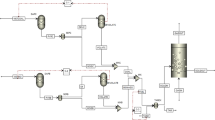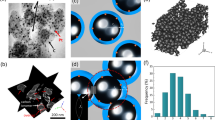Abstract
This paper addresses the effect of oxidizer particle orientation on the burning rate of ammonium-perchlorate-based heterogeneous solid propellants. Mesoscale numerical simulations are conducted assuming that oxidizer particles are ellipsoidal and have different orientations with respect to the combustion direction. The particle orientation is found to produce a significant effect on the burning rate, up to 5–10% depending on the particle aspect ratio or particle loading. Particles aligned normal to the combustion surface are found to burn faster than those aligned parallel to this surface. This strong impact of the orientation can help explain the well-known hump effect in solid propulsion.








Similar content being viewed by others

REFERENCES
M. W. Beckstead, “Overview of Combustion Mechanisms and Flame Structures for Advanced Solid Propellants," Prog. Astronaut. Aeronaut. 185, 267–286 (2000); DOI: 10.2514/5.9781600866562.0267.0285.
T. L. Jackson and J. Buckmaster, “Heterogeneous Propellant Combustion," AIAA J. 40 (6), 1122–1130 (2002); DOI: 10.2514/2.1761.
L. Massa, T. L. Jackson, and M. Short, “Numerical Solution of Three-Dimensional Heterogeneous Solid Propellants," Combust. Theory Model. 7 (3), 579–602 (2003); DOI: 10.1088/1364-7830/7/3/308.
D. Deepak, R. Jeenu, P. Sridharan, and M. S. Padmanabhan, “Direct Evidence of Spatial Burning Rate Variation as Cause of Midweb Anomaly," J. Propul. Power 17 (2), 449–452 (2001); DOI: 10.2514/2.5763.
T. E. Kallmeyer and L. H. Sayer, “Differences between Actual and Predicted Pressure–Time Histories of Solid Rocket Motors," in 18th AIAA/SAE/ASME Joint Propul. Conf., Cleveland, Ohio, July 21–23, 1982, AIAA Paper No. 1982-1094; DOI: 10.2514/6.1982-1094.
M. P. Friedlander and F. W. Jordan, “Radial Variation of Burning Rate in Center Perforated Grains," in 20th AIAA/SAE/ASME Joint Propul. Conf., Cincinnati, Ohio, June 11–13, 1984, AIAA Paper No. 1984-1442; DOI: 10.2514/6.1984-1442.
P. Le Breton and D. Ribéreau, “Casting Process Impact on Small-Scale Solid Rocket Motor Ballistic Performance," J. Propul. Power 18 (6), 1211–1217 (2002); DOI: 10.2514/2.6055.
S. D. Heister, “Ballistics of solid Rocket Motors with Spatial Burning Rate Variations," J. Propul. Power 9 (4), 649–651 (1993); DOI: 10.2514/3.23671.
K. Kitagawa, T. Shimada, H. Hasegawa, et al., “Correlation of Midweb Anomaly with Microstructure of Composite Propellant Containing High Amount of Aluminum," in 47th AIAA/ASME/SAE/ASEE Joint Propul. Conf. and Exhibit, San Diego, California, July 31 to August 03, 2011, AIAA Paper No. 2011-5714; DOI: 10.2514/6.2011-5714.
X. Wang, J. Buckmaster, and T. L. Jackson, “Burning of Ammonium-Perchlorate Ellipses and Spheroids in Fuel Binder," J. Propul. Power 22 (4), 764–768 (2006); DOI: 10.2514/1.15739.
M. Plaud, S. Gallier, and M. Morel, “Simulations of Heterogeneous Propellant Combustion: Effect of Particle Orientation and Shape," Proc. Combust. Inst. 35 (2), 2447–2454 (2015); DOI: 10.1016/j.proci.2014.05.020.
S. Gallier, A. Ferrand, and M. Plaud, “Three-Dimensional Simulations of Ignition of Composite Solid Propellants," Combust. Flame 173, 2–15 (2016); DOI: 10.1016/j.combustflame.2016.07.012.
S. Gallier and M. Plaud, “A Model for Solid Propellant Burning Fluctuations Using Mesoscale Simulations," Acta Astronaut. 158, 296–303 (2019); DOI: 10.1016/j.actaastro.2019.03.029.
S. Jain, M. Mehilal, S. Nandagopal, et al., “Size and Shape of Ammonium Perchlorate and Their Influence on Properties of Composite Propellant," Defence Sci. J. 59 (3), 294–299 (2009); DOI: 10.14429/dsj.59.1523.
M. Chen, J. Buckmaster, T. L. Jackson, and L. Massa, “Homogenization Issues and the Combustion of Heterogeneous Solid Propellants," Proc. Combust. Inst. 29 (2), 2923–2929 (2002); DOI: 10.1016/S1540-7489(02)80357-1.
S. Torquato, Random Heterogeneous Materials: Microstructure and Macroscopic Properties (Springer, 2013), Vol. 16.
Author information
Authors and Affiliations
Corresponding authors
Additional information
Translated from Fizika Goreniya i Vzryva, 2021, Vol. 57, No. 6, pp. 56-64.https://doi.org/10.15372/FGV20210607.
Rights and permissions
About this article
Cite this article
Gallier, S., Plaud, M. Effect of Particle Orientation on the Burning Rate of Ammonium-Perchlorate-Based Solid Propellants. Combust Explos Shock Waves 57, 685–692 (2021). https://doi.org/10.1134/S0010508221060071
Received:
Revised:
Accepted:
Published:
Issue Date:
DOI: https://doi.org/10.1134/S0010508221060071



